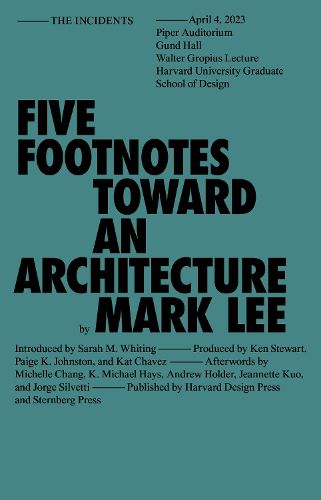Readings Newsletter
Become a Readings Member to make your shopping experience even easier.
Sign in or sign up for free!
You’re not far away from qualifying for FREE standard shipping within Australia
You’ve qualified for FREE standard shipping within Australia
The cart is loading…






Architect Mark Lee presents a body of work on the basis of five considerations- on history, on cadence, on autonomy, on America, and on point.
Architect Mark Lee presents a body of work on the basis of five considerations- on history, on cadence, on autonomy, on America, and on point.
On the occasion of his fifth and final year as Chair of the Department of Architecture at the Harvard University Graduate School of Design, architect and educator Mark Lee strings together five "footnotes"-on history, on cadence, on autonomy, on America, and on point-to assess the relationship between architectural education, research, and professional practice. Evoking a similar position that marked his tenure, Lee delivers a lecture that embraces dialogue, context, and precedent, and rejects the notion of a heroic manifesto in favor of the footnote- "something ancillary, something used for referencing and providing citations for metanarratives that already exist." And why five? "It's a ubiquitous number in the culture of architecture. Five orders, five architects, five points."
Copublished by Harvard Design Press
$9.00 standard shipping within Australia
FREE standard shipping within Australia for orders over $100.00
Express & International shipping calculated at checkout
Architect Mark Lee presents a body of work on the basis of five considerations- on history, on cadence, on autonomy, on America, and on point.
Architect Mark Lee presents a body of work on the basis of five considerations- on history, on cadence, on autonomy, on America, and on point.
On the occasion of his fifth and final year as Chair of the Department of Architecture at the Harvard University Graduate School of Design, architect and educator Mark Lee strings together five "footnotes"-on history, on cadence, on autonomy, on America, and on point-to assess the relationship between architectural education, research, and professional practice. Evoking a similar position that marked his tenure, Lee delivers a lecture that embraces dialogue, context, and precedent, and rejects the notion of a heroic manifesto in favor of the footnote- "something ancillary, something used for referencing and providing citations for metanarratives that already exist." And why five? "It's a ubiquitous number in the culture of architecture. Five orders, five architects, five points."
Copublished by Harvard Design Press